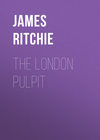Читать книгу: «Days and Nights in London: or, Studies in Black and Gray»
PREFACE
London has vastly altered since the Author, some quarter of a century ago, described some of the scenes which occurred nightly in its midst of which respectable people were ignorant, which corrupted its young men and young women, and which rendered it a scandal and a horror to civilisation itself. The publication of his work, “The Night Side of London” – of which nearly eight thousand copies were sold – did something, by calling the attention of Members of Parliament and philanthropists to the subject, to improve the scenes and to abate the scandal. As a further contribution to the same subject, the present volume is published. Every Englishman must take an interest in London – a city which it has taken nearly two thousand years to build; whose sons, to enrich which, have sailed on every sea and fought or traded on every land; and which apparently, as the original home and centre of English-speaking people, must grow with the growth and strengthen with the strength of the world.
Wrentham House, Hendon,
February, 1880.
I. – THE WORLD OF LONDON
London, for a “village,” as old Cobbett used to call it, is a pretty large one; and, viewed from the lowest stand-point – that of the dull gospel according to Cocker – may well be described as truly wonderful. It eats a great deal of beef, and drinks a great deal of beer. You are staggered as you explore its warehouses. I stood in a granary the other day in which there were some eighty thousand sacks of wheat; and in the Bank of England I held in my hand, for a minute – all too brief – a million of pounds. It is difficult to realise what London is, and what it contains. Figures but little assist the reader.
Perhaps you best realise what the city is as you come up the Thames as far as London Bridge. Perhaps another way is to stand on that same bridge and watch the eager hordes that cross of a morning and return at night, and then, great as that number is, to multiply it a hundredfold. A dozen miles off gardeners tell you that there are plants that suffer from London air and London fog. Indeed it is difficult to say where London begins and where it ends. If you go to Brighton, undoubtedly it is there in all its glory; when yachting far away in the western islands of Scotland and the Hebrides, the first signature I found in the strangers’ book at a favourite hotel was that of Smith, of London. There he was, as large as life, just as we see him any day in Cheapside. One bitter cold winter day I revisited, not exactly my childhood’s happy home, but a neighbouring sea port to which I was once much attached. “Oh,” said I to myself, as I rushed along in the train, “how glad people will be to see me; how bright will be the eyes into which I once loved to look, and how warm the clasp of the hand which once thrilled through all my being!” Alas! a generation had risen who knew not Joseph. I dined sadly and alone at the hotel, and after dinner made my way to the pier to mingle my melancholy with that of the melancholy ocean. The wind was high; the sand in clouds whirled madly along the deserted streets. At sea even nothing was to be seen; but at the far end of the pier, with his back turned to me, gazing over as if he wanted to make out the coast of Holland – some hundred and fifty miles opposite – was a short man, whom I knew at once from his apoplectic back – Brown, of Fleet Street – come there all the way from the congenial steak puddings and whisky toddy of The Cheshire Cheese for a little fresh air! I felt angry with Brown. I was ready almost to throw him over into the raging surf beneath, but I knew that was vain. There were “more to follow.” Nowadays London and London people are everywhere. What is London? It covers, says one, within a fifteen-miles’ radius of Charing Cross, so many hundred square miles. It numbers more than four million inhabitants. It comprises a hundred thousand foreigners from every quarter of the globe. It contains more Roman Catholics than there are in all Rome; more Jews than there are in all Palestine; and, I fear, more rogues than there are even in America. On a Sunday you will hear Welsh in one church, Dutch in another, the ancient dialect of St. Chrysostom in another; and on a Saturday you may plunge into low dancing-houses at the East-End which put to shame anything of the kind in Hamburg or Antwerp or Rotterdam. In many of the smoking-rooms bordering on Mark Lane and Cheapside you hear nothing but German. I know streets and squares inhabited by Dutch and German Jews, or dark-eyed Italians, or excitable Frenchmen, where is as little understood as Sanscrit itself. At any moment I like I can rush away from all European civilisation, and sit in a little room and smoke opium with the heathen Chinee – whose smile all the while is “childlike and bland” – as if I were thousands of miles away. On the other side of St. Paul’s I have supped with hundreds of thieves at a time, who carry on their work as if there was no such institution as that of the police; I have listened to the story of the crowded lodgers, and I can believe anything you like to tell me of the wealth, of the poverty, of the virtue, of the vice of London. People say the metropolis has seven thousand miles of streets. I have no doubt it has. People say it has on Sunday sixty miles of shops open, and they may be right; at least I have neither the time nor the inclination to test these figures. It also rejoices, I hear, in as many public-houses as, if set in a line, would reach from Charing Cross to Portsmouth. The people of London read or write in the course of a year as many as two hundred and forty millions of letters. All these letters are written, all these public-houses supported, all these streets lined with houses inhabited by men who more or less are connected with the city. It is there they live, if they sleep fifty miles away, and it is a hard life some of them have assuredly. A little while ago a poor woman was charged with pawning shirts entrusted to her to make by an East-End merchant clothier. The woman pleaded that her children were so hungry that she was tempted to pawn some of the work in the hope of being able to redeem it by the time the whole was completed. The work was machine-sewing. She hired the machine at half-a-crown a week, and was paid by the prosecutor a shilling a dozen for his shirts.
The tongue that Shakespeare spake
“Nonsense,” said the magistrate; “that is only a penny each.”
“And that is all it is, sir,” said the poor woman.
“And you have to work a long day to make twelve. And is it really a fact,” said the magistrate, turning to the merchant clothier, “that this kind of work has fallen into such a deplorable condition that you can get it done at so poor a rate?”
“Your worship,” was the reply, “if I wanted a hundred hands at the price I could get ’em by holding up my finger.”
Nowhere does life run to such extremes; – nowhere is there such pauperism as in London; nowhere is there such wealth; nowhere does man lift a sublimer face to the stars; nowhere does he fall so low. In short, London may be described as “one of those things which no fellah can understand.”
In beauty London now may almost vie with fair bewitching Paris. In all other respects it leaves it far behind. It is the brain of England, the seat of English rule, whence issue laws which are obeyed in four quarters of the globe, and the fountain of thought which agitates and rules the world. London is the head-quarters of commerce. Tyre and Sidon and Carthage, the republics of Italy, the great cities of the Hanseatic Confederation, Flemish Ghent or Bruges, or Antwerp or busy Amsterdam, never in their canals, and harbours, and rivers, sheltered such burdened argosies; in their streets never saw such wealthy merchants; in their warehouses never garnered up such stores of corn and wine and oil. London prices rule the globe, and are quoted on every exchange. It is a city of contrasts. It has its quarters where pale-eyed students live and move and have their being, and factories where the only thought is how best to drag out a dull mechanical life. It has its underground cells where misers hide their ill-gotten gains, and its abodes of fashion and dissipation where the thoughtless and the gay dance and drink and sing, as if time past taught them no lesson, and as if time to come could have no terrors for them. It is a city of saints and sinners, where God and Mammon have each their temples and their crowds of worshippers. Here lie in wait the traffickers in men’s bodies and souls; and here live those whose most anxious care is how best to assuage the pangs of poverty, how best to cure the delirium of disease, how most successfully to reclaim the fallen and the prodigal, how most assiduously to guard the young from the grasp of the destroyer – how, in the language of the poet, to “allure to brighter worlds and lead the way.” If there be a fire in Chicago, a famine in India, a tornado in the West Indies, a wail of distress from the North or the South, or the East or the West, London is the first city to send succour and relief.
In speaking of London we sometimes mean Smaller London and sometimes Greater London. To avoid confusion we must clearly understand what is meant by each. Smaller London comprises 28 Superintendent Registrars’ Districts, 20 of them being in Middlesex, 5 in Surrey, and 3 in Kent; viz. Kensington, Chelsea, St. George, Hanover Square, Westminster, Marylebone, Hampstead, Pancras, Islington, Hackney, St. Giles, Strand, Holborn, London City, Shoreditch, Bethnal Green, Whitechapel, St. George in the East, Stepney, Mile End and Poplar in Middlesex; St. Saviour, Southwark, St. Olave, Southwark, Lambeth, Wandsworth, and Camberwell in Surrey; and Greenwich, Lewisham, and Woolwich in Kent. It had an estimated population in the middle of 1878 of 3,577,304. Greater London comprises in addition to the above 14 Superintendent Registrars’ Districts, 6 of them being in Middlesex, 4 in Surrey, 2 in Kent, and 2 in Essex; viz. Staines, Uxbridge, Brentford, Hendon, Barnet, and Edmonton in Middlesex; Epsom, Croydon, Kingston, and Richmond in Surrey; Bromley and Bexley in Kent; and West Ham and Romford in Essex. It comprises the whole of Middlesex, and such parishes of Surrey, Kent, Essex, and Herts as are within 12 miles of Charing Cross. These additional districts had an estimated population of 872,711 in the middle of the year 1878, so that Greater London has therefore at the present time a population of 4,450,015. The population of the United Kingdom in the middle of 1878 was estimated at 33,881,966. Greater London had therefore considerably more than an eighth of the population of Great Britain and Ireland, and more than a sixth of the population of England and Wales. This large population is constantly and rapidly increasing; the estimated increase in 1878 being 82,468. It is important to note that the increase is not equal in all parts. The population is decreasing within the City; within Smaller London it goes on increasing but at a decreasing rate, and in the outer ring the population increases steadily at an increasing rate. The population of the outer circle has increased more than 50 per cent. in the last ten years.
Even in its narrowest definition – as the small plot of ground between Temple Bar and Aldgate pump – what a history London has! Of what scenes of glory and of shame it has been the theatre! What brave men and lovely women have played their part, heroic or the reverse, upon its stage! When the City’s greatest architect dug deep into the earth to build the foundations of his matchless cathedral, he laid bare the remains of nations and generations that one after another had held the City as its own. First he uncovered the graves of the early medieval Londoners; then he came to the remains of our Saxon forefathers, of Ethelbert and St. Augustine; next were found the remains of Romans and ancient Britons, and last of all were found the mouldering remains of those who knew not Cæsar and the city they call Rome. Again, the London of Victoria faintly resembles the London of Queen Anne, as faintly perhaps as does the Jerusalem of to-day represent the city in which our Saviour dwelt. No wonder that our old chroniclers romanced not a little, and that many of them did believe, as Geoffrey of Monmouth writes, that London was founded by Brute, a descendant of Eneas, eleven hundred years before Christ, and that he called it Troy Novant, whence came the name of the people to be called Trinobantes. Equally widespread and equally unfounded was the belief that from London were shipped away eleven thousand – some say seventy thousand – British virgins (as an admirer of the virtues of my countrywomen I stick to the highest figure) – whose bones may yet be seen in Cologne – to the British warriors compelled to settle in Armorica. What is clear, however, is that in London Diana had a temple, that the Saxons won the city from the Britons, that the Tower of London is one of the oldest buildings in Christendom, and that here Roman and Dane, and Saxon and Norman have all more or less left their mark. Our early monarchs trembled as they saw how the great city grew. When that slobbering James came to the throne – whom his courtiers denominated the British Solomon – of whom bishops and archbishops testified that his language was that of inspiration, he exclaimed, “England will shortly be London, and London England,” as he saw how people were adding house to house and street to street, and flocking to them from all parts of England and Scotland; yet the London of the Stuarts, neither in extent or magnificence or wealth, bore the faintest resemblance to the London of to-day.
Londoners are well looked after in the matter of taxes. The ratable value of the metropolis, or rather the district of the Metropolitan Board, is £23,960,109. Last year it raised in this way £477,835. The School Board rate was something similar. Besides, there is a sewer rate of twopence in the pound; a paving, watering, etc. rate of probably ninepence; a lighting rate of threepence; then there are rates to pay interest on the debts of extinct paving trusts; a rate for baths and wash-houses, police rate and county rate, making a total of almost five shillings and sixpence in the pound on the value of a house. While it has an excess of beer-shops, gin-palaces, and music-halls, it has a great deficiency as regards church and chapel accommodation. In Inner London it is calculated 955,060 sittings are required. In Larger London the deficiency, it is estimated, is much more.
The number of police, according to the last return, was 10,336 in the metropolis, showing an increase of 0.5 per cent. over last year; and in the City 798, being seven over the last returns. The metropolitan police are in the proportion of one for every 397 of the population of the metropolitan police district; the City police of one for every 93 of the population, as enumerated on the night of the census of 1871. The cost of the metropolitan police was £1,077,399, of which 39.9 per cent. was contributed from public revenue; the cost of the City police was £85,231, towards which no contribution was made. From the criminal returns it appears that for the metropolitan police district, with the City, the number of known thieves and depredators, receivers of stolen goods, and suspected persons, was 2,715, or one in 1,431 of the population, showing an increase of 3.9 per cent. on the returns of the previous year. The rule which has been followed now for 14 years, that persons known to have been living honestly for one year at least subsequently to their discharge after any conviction, should not be returned in the class of known thieves and depredators, has been adhered to. The return of houses of bad character in the metropolis, exclusive of those of ill-fame and of those returned to Parliament under the Contagious Act, is 215, of which 66 are houses of receivers of stolen goods, showing a decrease of 22 in the year. The total number of cases tried at the Central Criminal Court was 10,151. From a classification of offences determined summarily we learn that there were 5,622 persons proceeded against in the City, of whom 1,093 were discharged, and the remainder convicted or otherwise dealt with. There were 191 offences against the Adulteration of Food Act in the metropolitan police district, 7 in the City; 5,874 against the Elementary Education Act, none in the City; 1,234 cases of cruelty to animals in the metropolitan district, 823 in the City; 33,520 persons were drunk and disorderly in the metropolitan district, 431 in the City, being an increase over the numbers for the last year of about 1,000 in the first instance, and 35 in the second.
From the prison returns we gather that the total of commitments to Newgate for the year ended September 29th, 1877, was 1,394 males, and 218 females, being in the case of the males a reasonable decrease from the last year’s numbers; to Holloway, 1,896 males, 281 females, the latter returns including 841 males and 45 females to the civil side for debt. Under the heading of expenses we have £127 19s. for new buildings, alterations, etc., in Newgate; and in Holloway, £199; ordinary repairs in Newgate came to £149 11s. 4d., rent, rates, taxes, etc., £121 7s.; Holloway repairs, £121 4s. 5d., rent and taxes, £74 2s. 11d., with various other charges, making a total of expenses at Newgate of £6,514 5s. 3d.; Holloway, £10,314 9s. 9d. From the table of funds charged with prison expenses we learn that at Holloway the net profit of prisoners’ labour was £2,038 1s. 9d. The county or liberty rates contributed £83 16s. 8d. to Newgate; the City rate was £5,632 1s. 3d., the latter rate was, in respect to Holloway, £6,239 5s. The Treasury paid £347 0s. 9d., proportion of the charge for convicted prisoners at Newgate, £1,438 17s. 6d. for those at Holloway.
The charitable contributions of England are to-day in excess of what the whole revenue of the British Crown was under the Stuarts, only two hundred years ago; over £600,000 per annum is derived from all such sources by the medical charities of London alone; more than 1,200,000 persons, exclusive of paupers, are annually recipient of assistance from those medical charities.
In other ways also is London truly wonderful. It seems as if the earth toiled and moiled to simply supply her wants. Sail up the Baltic and ask whither those vessels laden with tallow and corn and flax are steering, and the answer is, The Thames. Float down the Mediterranean, and the reply to the question would be still the same. Ascend the grand rivers of the New World, and the destination of the stores of beef and cheese and wheat is still the same. Canada supplies us with our deals; America with half our food; Australia with our wool; the Cape with our diamonds; the Brazils with coffee. Havannah sends her choice cigars, China her teas, Japan her lacquered and ingenious ware, Italy her silks; and from the vineyards of France, or the green hills that border the Rhine and the Moselle, we are supposed to draw our supplies of sparkling wine. Spain sends her sherry, Portugal her port. For us the spicy breezes blow soft on Ceylon’s isle, the turtle fattens languidly under burning suns, the whale wallows in the trough of frozen seas, the elephant feeds in African jungles, and the ostrich darts as an arrow across the plain. In the country village, in the busy mill, on sea or on land, it is the thought of London that fires the brain and fills the heart, and nerves the muscle and relieves the tedium of nightly or daily toil. As Cowper writes:
Where has commerce such a mart,
So rich, so thronged, so drained, and so supplied,
As London – opulent, enlarged, and still
Increasing London? Babylon of old
Not more the glory of the earth than she,
A more accomplished world’s chief glory now.
It is not our province to speculate as to the future. There are men who tell us that Babylon is about to fall, and that it is time for the elect to be off. It may be so. Time, the destroyer, has seen many a noble city rise, and flourish, and pass away; but London, it must be admitted nevertheless, never more truly in any sense deserves the epitaph of “wonderful” than at the present time.
Покупайте книги и получайте бонусы в Литрес, Читай-городе и Буквоеде.
Участвовать в бонусной программе



















